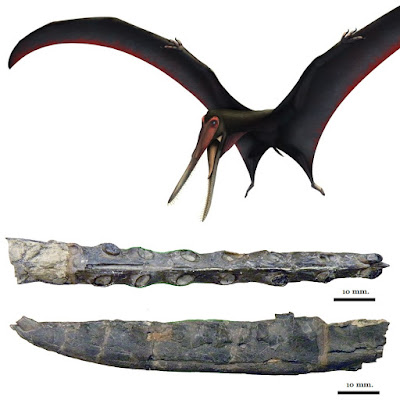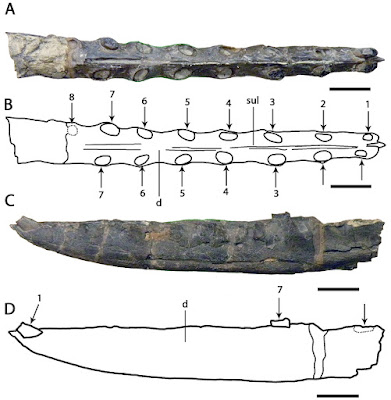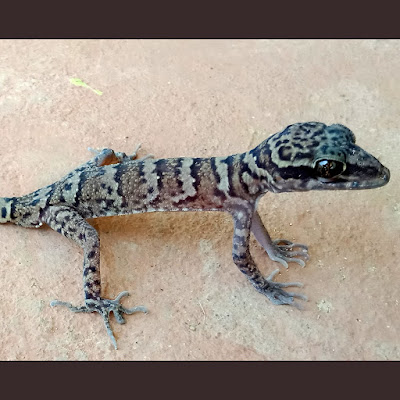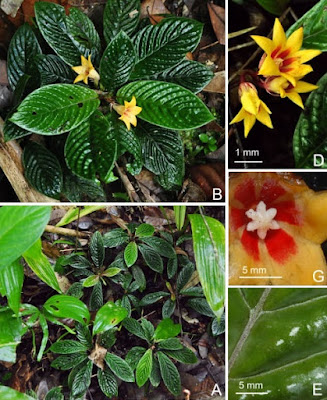[Most Recent Entries] [Calendar View]
Thursday, November 28th, 2019
| Time | Event | ||||
| 9:07a | [Paleontology • 2019] On Targaryendraco wiedenrothi gen. nov. (Pterodactyloidea, Pteranodontoidea, Lanceodontia) and Recognition of A New Cosmopolitan Lineage of Cretaceous Toothed Pterodactyloids
ABSTRACT Ornithocheirus wiedenrothi, from the Hauterivian (Early Cretaceous of Germany), is a taxon represented by three-dimensional remains of the lower jaw and wing elements. Its phylogenetic affinities have for long been elusive, though several works had already pointed out that it probably did not belong within the wastebasket genus Ornithocheirus. In the present contribution, we redescribe this species, assigning it to the new genus Targaryendraco and offering updated morphological comparisons. Subsequently, we present a phylogenetic analysis in which we recover a clade formed by Targaryendraco, Aussiedraco, Barbosania, Aetodactylus, Camposipterus and Cimoliopterus. This newly recognised clade is interesting in being quite cosmopolitan and spanning from the Hauterivian to the Cenomanian, like its sister-group, the Anhangueria. The recognition of this clade helps fill the temporal gap between the Anhangueria and Cimoliopterus, and also demonstrates that the diversity of Cretaceous toothed pterosaurs was higher than previously thought. KEYWORDS: Pterosaur phylogeny, systematics, taxonomy, skull morphology, Targaryendraconia Systematic palaeontology Pterosauria Kaup, 1834 Pterodactyloidea Plieninger, 1901 Ornithocheiroidea Seeley 1870 sensu Bennett, 1994 Pteranodontoidea Marsh, 1876 sensu Kellner 2003 Lanceodontia Andres et al. 2014 Targaryendraconia new clade Type genus: Targaryendraco gen. nov. Content: Targaryendraco, Aussiedraco, Barbosania, Aetodactylus, Camposipterus and Cimoliopterus. Cimoliopteridae new clade Type genus: Cimoliopterus. Content: Aetodactylus, Camposipterus and Cimoliopterus.
Targaryendraconidae new clade Type genus: Targaryendraco gen. nov. Content: Targaryendraco, Aussiedraco and Barbosania. Targaryendraco gen. nov. Etymology A combination of Targaryen and draco (from the Latin word for dragon), in reference to the fictional dragons of the saga A Song of Ice and Fire that exhibit dark-coloured bones. This refers to the dark colour of the type specimen of Targaryendraco wiedenrothi comb. nov., as well as to the classic association between pterosaurs and dragons (e.g. Seeley 1870). This reference also honours the fact that pterosaurs have inspired some biological aspects of the dragons featured in the novels. Type species Ornithocheirus wiedenrothi Wild 1990. Targaryendraco wiedenrothi (Wild 1990) comb. nov. Rodrigo V. Pêgas, Borja Holgado and Maria Eduarda C. Leal. 2019. On Targaryendraco wiedenrothi gen. nov. (Pterodactyloidea, Pteranodontoidea, Lanceodontia) and Recognition of A New Cosmopolitan Lineage of Cretaceous Toothed Pterodactyloids. Historical Biology: An International Journal of Paleobiology. DOI: 10.1080/08912963.2019.1690482 Taissa Rodrigues and Alexander Wilhelm Armin Kellner. 2013. Taxonomic Review of the Ornithocheirus complex (Pterosauria) from the Cretaceous of England. ZooKeys. 308: 1-112. DOI: 10.3897/zookeys.308.5559 researchgate.net/publication/334706709_R Unusual toothy pterosaur found hidden in the wrong group on.natgeo.com/33psPKW via @NatGeoScience | ||||
| 9:15a | [Herpetology • 2019] Cyrtodactylus muangfuangensis • A New Species of Cyrtodactylus (Squamata: Gekkonidae) from Vientiane Province, northern Laos
Abstract A new species of the genus Cyrtodactylus from Vientiane Province, northern Laos is described based on morphological and molecular data. Cyrtodactylus muangfuangensis sp. nov. can be distinguished from remaining congeners by the following combination of characters: maximum SVL 83.9 mm; dorsal pattern consisting of dark nuchal loop, nape band and five dark transversal bands between limb insertions; intersupranasals two; dorsal tubercles present on occiput, body, hind limbs and tail base; 15 or 16 irregular dorsal tubercle rows at midbody; lateral folds clearly defined, without interspersed tubercles; 31–37 ventral scales between ventrolateral folds; six precloacal pores and 15 femoral pores in males, which are interrupted by six to eight poreless scales; six precloacal pitted scales plus in total 10–15 pitted femoral scales in females, which are separated by six to eight poreless scales; enlarged precloacal and femoral scales present; two or three postcloacal tubercles; median subcaudal scales transversely enlarged. In molecular analyses, the new species is strongly supported as a member of the Cyrtodactylus phongnhakebangensis species group, and weakly corroborated as a sister taxon to C. pageli. Pairwise genetic comparison shows that it is at least 18% divergent from other congeners in the species group based on a fragment of the mitochondrial cytochrome C oxidase subunit I gene. Keywords: Reptilia, Cyrtodactylus muangfuangensis sp. nov., morphology, phylogeny, taxonomy Cyrtodactylus muangfuangensis sp. nov. Saly Sitthivong, Vinh Quang Luu, Ngoan Van Ha, Truong Quang Nguyen, Minh Duc Le and Thomas Ziegler. 2019. A New Species of Cyrtodactylus (Squamata: Gekkonidae) from Vientiane Province, northern Laos. Zootaxa. 4701(3); 257–275. DOI: 10.11646/zootaxa.4701.3.3 | ||||
| 9:38a | [Botany • 2019] Acranthera collina (Rubiaceae) • A Splendid New Species from the Serikin Area, Kuching, Sarawak, Malaysia
Acranthera collina (Rubiaceae), a new species from Sarawak, Malaysia, on the island of Borneo, is described and illustrated. Acranthera collina resembles A. bullata Merr. but is easily distinguished by its ca. 10 pairs of lateral veins (vs. 13–15 pairs), 6-merous flowers (vs. 5-merous), golden yellow corolla (vs. red) and anthers ca. 5 mm long (vs. 10 mm long). Key words: Acranthera, Borneo, new species, Rubiaceae, Sarawak Acranthera collina C. W. Lin & C. H. Lee, sp. nov. Acranthera collina resembles A. bullata Merr. (1937: 284) in having bullate obovate leaves, a short stature and an erect habit, but differs in having fewer lateral veins (10 or 11 pairs in A. collina vs. 13–15 pairs in A. bullata), 6-merous flowers (vs. 5-merous), golden yellow corolla (vs. red), and smaller anthers (ca. 5 mm long in A. collina vs. 10 mm long). Distribution and habitat. Endemic to Sarawak. Currently known only from the Serikin area (Fig. 1); lowlands in mixed dipterocarp forest on riverbank and at base of limestone hills in semi-shaded and consistently humid areas, ca. 100 m elevation. Etymology. the epithet collina refers to the lowland mountains where Acranthera collina was collected. Che-Wei Lin and Chi-Hung Lee. 2019. Acranthera collina (Rubiaceae), A Splendid New Species from the Serikin Area, Kuching Division, Sarawak, Malaysia. Acta Phytotax. Geobot. 70(3); 189–194. DOI: 10.18942/apg.201904 |
| << Previous Day |
2019/11/28 [Calendar] |
Next Day >> |














